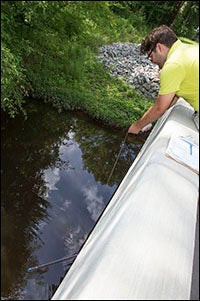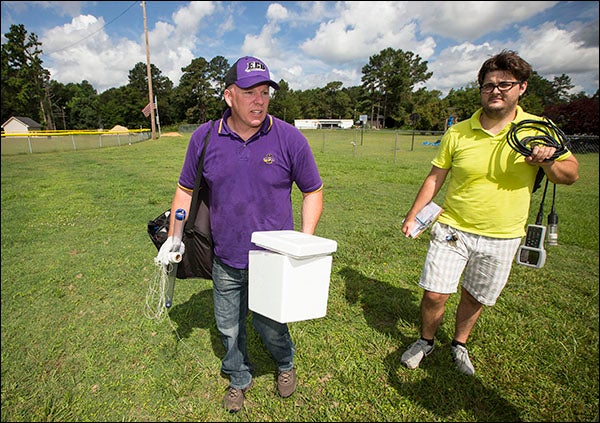BELOW THE SURFACE
Believed to be the first of its kind in the state, a barrier installed by East Carolina University researchers is reducing nitrate-nitrogen concentrations in eastern North Carolina groundwater.
Dr. Charles Humphrey, assistant professor of environmental health sciences in the College of Health and Human Performance, has been monitoring the groundwater at Rodgers Elementary School outside Williamston since May, when a permeable barrier was installed to improve quality.
Officials discovered a few years ago that the nitrate-nitrogen (NO3-N) concentration in groundwater near the school exceeded allowable state limits. Approximately 300 students are enrolled at Rodgers Elementary. While drinking water in nearby homes and the school isn’t at risk, state regulations required the levels be reduced.

Guy Iverson, a doctoral student in coastal resource management, samples water from Reedy Branch Creek, about 600 feet from the elementary School.
“No one drinks this but there is a groundwater standard they’re held to,” Humphrey said.
That’s when Martin County Schools turned to Humphrey and co-investigators on the project, Dr. Eban Bean, assistant professor in the ECU Department of Engineering and the Institute for Coastal Science and Policy, and Dr. Mike O’ Driscoll in the Department of Geology. They helped write a grant for $3,498 that was funded by the N.C. Department of Health and Human Services for the barrier installation.
Dr. Sushama Pradhan, program coordinator of non-point source pollution in health and human services, was instrumental in securing funding for the project, Humphrey said.
While nitrate is beneficial to plant growth, drinking water with high levels of nitrate potentially can be harmful to animals or people.
“Groundwater feeds surface waters, and elevated surface water NO3-N has been a problem for many waters in North Carolina, other regions of the United States and world,” Humphrey said.
The barrier system, which is low maintenance and cost effective, could be a model for other areas or settings, such as agricultural or waste application fields where nitrate-nitrogen concentrations could be elevated and potentially influence surface water nearby, Humphrey said. It has been used in other states.
“We have had surface water nutrient reduction rules and strategies for several watersheds in North Carolina for more than 15 years because of the problems associated with excess concentrations of nitrogen, such as algae blooms and fish kills,” Humphrey said. “This may be an additional tool that can be used to help reduce surface water nitrogen concentrations by addressing the groundwater NO3-N transport issue. The school and community can take pride in being the first site in the state to implement this technology.”
The barrier was dug near the school’s baseball field. The 20-foot trench is lined with about six to seven feet of wood chips and backfilled with soil. “It doesn’t prevent water from moving,” Humphrey said. “It helps convert the nitrate into gas.”
Since the barrier was installed May 7, groundwater samples show that nitrogen concentrations have been cut as much as half. “It’s still preliminary, but so far it’s looking good,” Humphrey said.
Brian Thomas, who helps maintain schools in the Martin County system, said he appreciates Humphrey and ECU.
“We’re not used to dealing with this type of issue,” Thomas said. “It’s never been a problem before. Charlie has been crucial to this project being done.”
Geology graduate student Sarah Hardison assisted with field surveys of the site and data collection. Guy Iverson, a doctoral student in coastal resource management, is conducting lab analysis of the nitrogen concentration in groundwater and septic effluent samples taken at the school.
Humphrey said they hope to continue monitoring beyond the grant’s timeline, possibly through graduate student work. “I use the data and information in some of my classes so students can see real world examples of applying science,” said Humphrey, whose research interests include on-site wastewater, soils and land use impacts on water quality.
ECU also has been sampling Reedy Branch Creek about 600 feet from the school. “I don’t think the groundwater NO3-N is influencing that creek,” Humphrey said. “Hopefully our barrier is working.”

Charles Humphrey, left, and Guy Iverson carry equipment for monitoring water quality across the campus of Rodgers Elementary School.